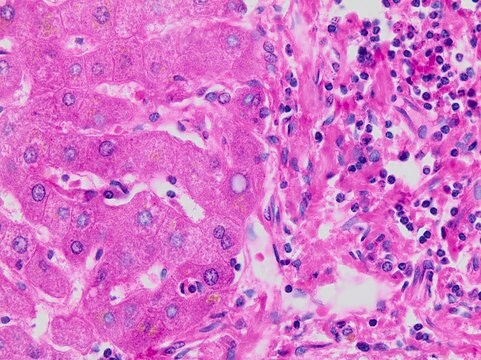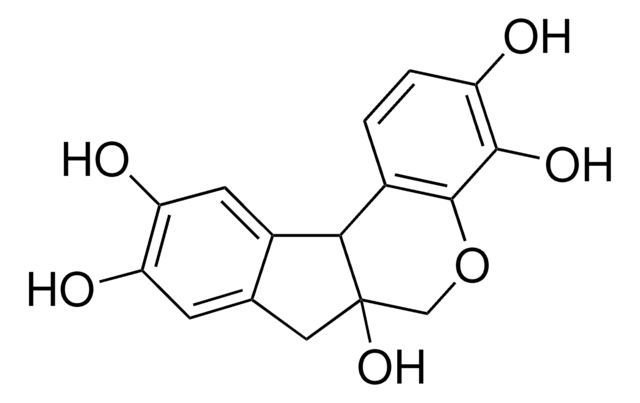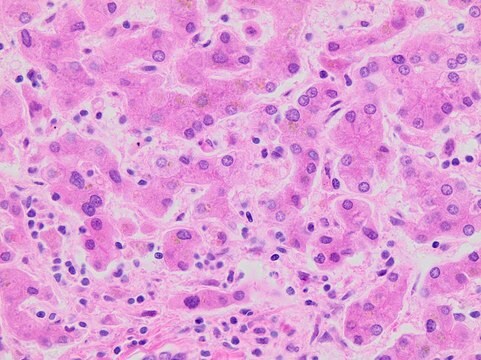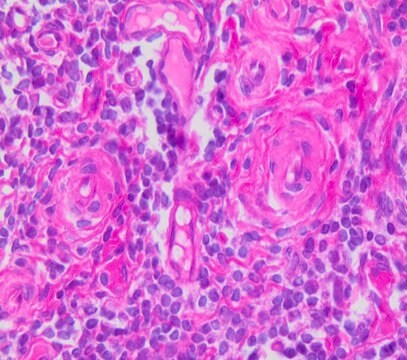A3429
Differentiation Solution
for the differentiation of regressive hematoxylin stains
Synonim(y):
Acid Alcohol
Zaloguj sięWyświetlanie cen organizacyjnych i kontraktowych
About This Item
Polecane produkty
Postać
solution
okres trwałości
40 mo.
kolor
colorless
Zastosowanie
hematology
histology
temp. przechowywania
room temp
Szukasz podobnych produktów? Odwiedź Przewodnik dotyczący porównywania produktów
Opis ogólny
Differentiation solution comprises acidified ethanol or isopropanol that is used to decolorize hematoxylin stain. The duration of exposure to the solution determines the degree of decolorization. Differentiation is a crucial step in hematoxylin-eosin staining to achieve the proper color contrast necessary for visualization, by selectively removing excess hematoxylin from the tissue section and leaving behind the desired staining intensity.
Zastosowanie
Differentiation solution is employed mainly for the differentiation of regressive hematoxylin stains. It has been used in the following studies:
- the prediction of pulmonary metastasis progression in osteosarcoma patients
- the development of multispectral imaging to detect melanin
Acidified alcohol solution for the differentiation of regressive hematoxylin stains.
Cechy i korzyści
- Desired staining patterns can be obtained by varying the degree of exposure to the differentiation solution.
- Results are sharper and more rapid compared to other differentiation methods.
- Crisp and clear differentiation between cellular structures is obtainable when performed according to Sigma-Aldrich Procedure No. GHS.
Zasada
In regressive hematoxylin staining, a highly concentrated hematoxylin solution is used to rapidly overstain both nuclei and cytoplasm, and the cytoplasm is subsequently decolorized and excess hematoxylin is removed from the nucleus with dilute acid. Improper differentiation leaves excess residual hematoxylin that obscures the fine details of nuclear structures and chromatin and prevents eosin uptake.
This page may contain text that has been machine translated.
Hasło ostrzegawcze
Danger
Zwroty wskazujące rodzaj zagrożenia
Zwroty wskazujące środki ostrożności
Klasyfikacja zagrożeń
Eye Irrit. 2 - Flam. Liq. 2 - Met. Corr. 1 - STOT SE 2
Organy docelowe
Eyes,Central nervous system
Kod klasy składowania
3 - Flammable liquids
Klasa zagrożenia wodnego (WGK)
WGK 1
Temperatura zapłonu (°F)
71.6 °F
Temperatura zapłonu (°C)
22 °C
Certyfikaty analizy (CoA)
Poszukaj Certyfikaty analizy (CoA), wpisując numer partii/serii produktów. Numery serii i partii można znaleźć na etykiecie produktu po słowach „seria” lub „partia”.
Masz już ten produkt?
Dokumenty związane z niedawno zakupionymi produktami zostały zamieszczone w Bibliotece dokumentów.
Nasz zespół naukowców ma doświadczenie we wszystkich obszarach badań, w tym w naukach przyrodniczych, materiałoznawstwie, syntezie chemicznej, chromatografii, analityce i wielu innych dziedzinach.
Skontaktuj się z zespołem ds. pomocy technicznej









